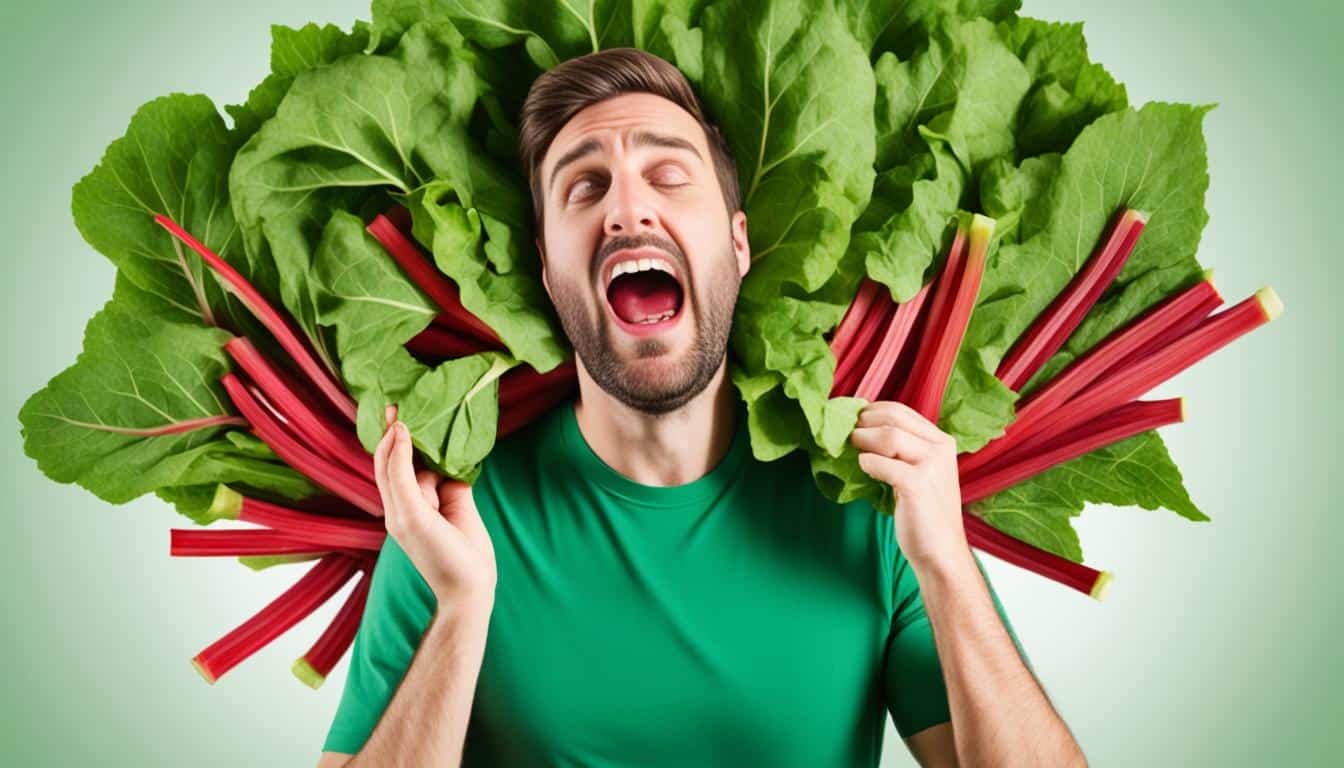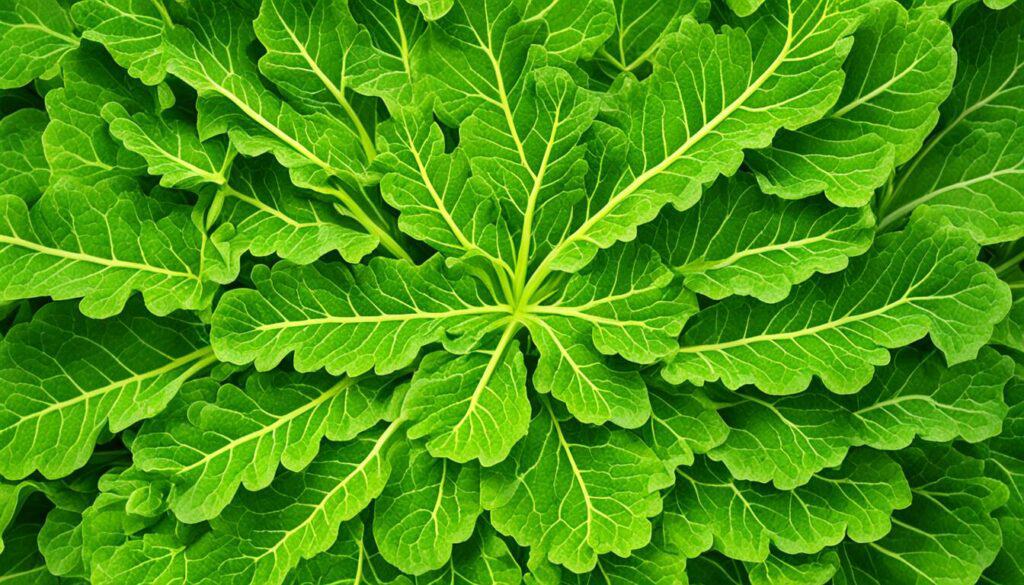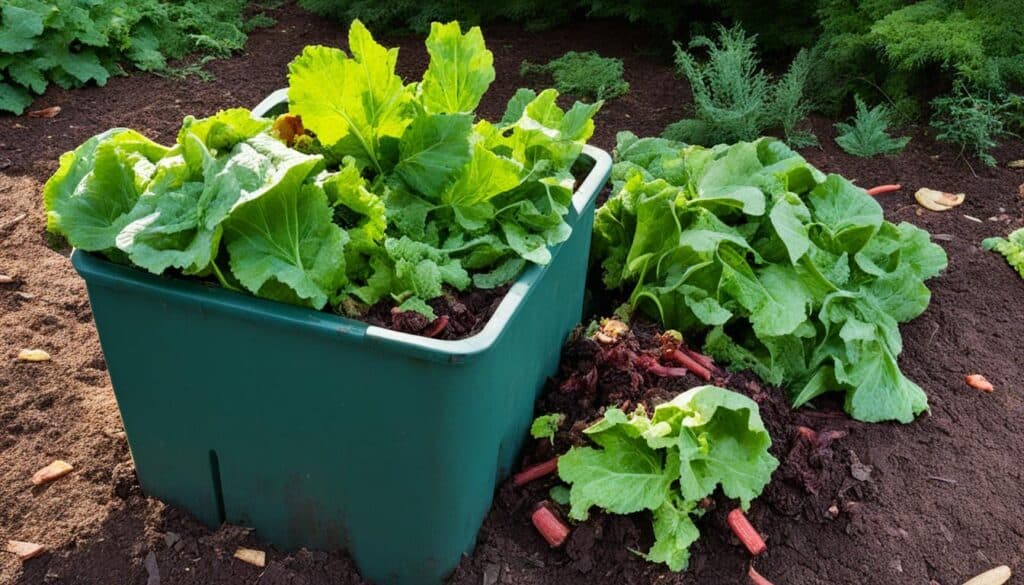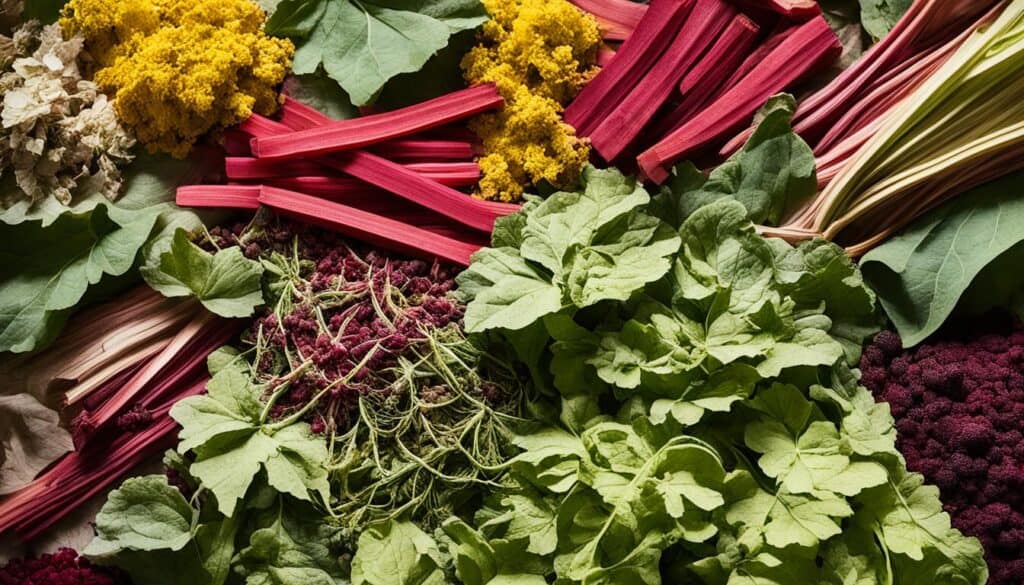Did you know that rhubarb, a popular vegetable in Europe and North America, is classified as a fruit in the United States? While rhubarb stalks are commonly consumed and used in various dishes, there is a hidden danger lurking in this plant. The leaves of rhubarb are not only inedible but can also be toxic if ingested. This surprising fact highlights the importance of understanding the potential hazards of consuming rhubarb leaves.
Key Takeaways:
- Rhubarb leaves should never be eaten as they contain a high concentration of oxalic acid.
- Oxalic acid can lead to symptoms of oxalate toxicity and even kidney damage.
- The symptoms of rhubarb leaf poisoning range from mild gastrointestinal issues to more severe conditions like kidney stones and kidney failure.
- Reports of poisoning from eating rhubarb leaves are rare, but it’s best to err on the side of caution and avoid consumption.
- Rhubarb leaves can be safely composted and repurposed for other uses, such as organic pesticides and natural dyes.
Why Are Rhubarb Leaves Considered Toxic?
Rhubarb leaves are considered toxic due to their high content of oxalic acid. Both the stalks and leaves of rhubarb contain oxalic acid, but the leaves have a much higher concentration.
Oxalic acid is a natural substance found in many plants and can be harmful when consumed in high amounts. It can lead to hyperoxaluria, a condition characterized by the excretion of excess oxalate in the urine, which can result in the formation of calcium oxalate crystals in the organs. This can lead to the development of kidney stones and, in severe cases, kidney failure.
Rhubarb leaf toxicity is primarily attributed to the presence of oxalic acid. The body needs a certain amount of oxalic acid for normal bodily functions, but excessive consumption can overwhelm the kidneys’ capacity to eliminate it, leading to the accumulation of calcium oxalate crystals. These crystals can then aggregate and form kidney stones, causing pain and potential damage to the kidneys.
Symptoms of Rhubarb Leaf Poisoning
Rhubarb leaf poisoning can lead to various symptoms, depending on the severity of oxalate toxicity. Mild cases may cause transient symptoms like vomiting and diarrhea, which usually resolve within a few hours. However, more serious cases can manifest with a sore throat, difficulty swallowing, persistent nausea, vomiting (sometimes with blood), diarrhea, and abdominal pain. In severe instances, symptoms may progress to kidney failure, accompanied by numbness, muscle twitches, and cramps. If you experience any of these symptoms after consuming rhubarb leaves, it is crucial to seek immediate medical attention, as they may indicate oxalate toxicity and potential kidney damage.
Understanding the Symptoms
The symptoms of rhubarb leaf poisoning vary and can present differently in individuals. Initial gastrointestinal symptoms like vomiting and diarrhea occur due to the irritation caused by oxalate crystals. These symptoms are typically self-limiting and subside over time.
“It’s important to be aware that more severe symptoms, such as kidney failure, can manifest in cases of extreme oxalate toxicity.”
In cases where oxalate toxicity is severe, symptoms can progress to include sore throat and difficulty swallowing due to the throat and gastrointestinal tract’s inflammation. Persistent nausea, vomiting (sometimes with blood), diarrhea, and abdominal pain are signs of possible toxicity-related organ damage.
Moreover, in severe cases, oxalate crystals may accumulate in the kidneys, leading to kidney failure. This can result in symptoms such as numbness, muscle twitches, and cramps. Kidney failure is a serious complication that requires immediate medical intervention.
Rarity of Rhubarb Leaf Poisoning Cases
Reports of poisoning from eating rhubarb leaves are rare. While rhubarb leaves contain a high concentration of oxalic acid, the lethal dose is estimated to be around 170 mg per pound of body weight. This means that a person would need to consume a large amount of rhubarb leaves to reach a potentially lethal dose. However, there have been historical reports of poisonings and even deaths from consuming rhubarb leaves, particularly when they were used as a substitute for other vegetables during times of food shortage.
It’s important to note that high intake of rhubarb stems, which also contain oxalic acid, can lead to kidney damage. While the risk of developing kidney problems from oxalates varies from person to person, certain individuals may be more susceptible. Factors such as genetic conditions or existing kidney damage can increase the likelihood of experiencing kidney damage.
Although rare, the potential risks associated with consuming rhubarb leaves highlight the importance of exercising caution and understanding the potential consequences.
The Bottom Line on Rhubarb Leaves
In conclusion, while rhubarb leaves have some potential uses, such as making organic pesticides or natural dyes, they are not safe for consumption due to their high oxalic acid content. The symptoms of rhubarb leaf poisoning can range from mild gastrointestinal symptoms to more severe issues like kidney stones and kidney failure.
Reports of poisoning from eating rhubarb leaves are rare, but it’s best to avoid consuming them, especially if you have any conditions that increase your risk of kidney stones. It’s always important to properly identify and understand the potential risks of the plants you encounter.
Rhubarb Leaf Benefits
Although consuming rhubarb leaves is not recommended, there are some potential benefits associated with these leaves:
- Organic Pesticides: Rhubarb leaves contain natural compounds that can be extracted and used to create organic pesticides for plants. These pesticides can help protect your garden from pests without the use of harmful chemicals.
- Natural Dyes: Boiling rhubarb leaves can produce a green dye that can be used to color fabrics. This natural dyeing method is eco-friendly and can be a fun project for crafts and DIY enthusiasts.
While these benefits exist, it’s important to note that the risks outweigh the potential advantages, making it best to avoid consuming rhubarb leaves altogether.
Rhubarb Leaf Identification
Proper identification of rhubarb leaves is crucial to avoid any accidental ingestion. Here are some key characteristics to look for when identifying rhubarb leaves:
| Characteristics | Description |
|---|---|
| Large Size | Rhubarb leaves are typically large, reaching up to 2 feet in diameter. They have long, thick petioles (stalks) that are often reddish or green. |
| Heart-shaped Base | The base of the rhubarb leaf is heart-shaped, with rounded or slightly lobed edges. |
| Deep Green Color | Rhubarb leaves have a vibrant, deep green color that can be shiny or matte, depending on the individual plant. |
| Hairless Surface | The surface of rhubarb leaves is smooth and hairless, with visible veins branching out from the center. |
It’s important to note that these identification features are specific to rhubarb leaves and may not be applicable to other plants with similar-looking leaves. When in doubt, consult a reliable botanical resource or a knowledgeable expert to ensure accurate identification.
“The potential risks outweigh the potential advantages, making it best to avoid consuming rhubarb leaves altogether.”
Always prioritize safety and rely on trusted sources when it comes to plant consumption and identification.
Composting Rhubarb Leaves
If you have rhubarb leaves that you need to dispose of, composting is a great option. Rhubarb leaves can be safely composted, as they are only harmful when ingested. Composting is an eco-friendly way to reduce food waste and create nutrient-rich soil for gardening.
To start composting your rhubarb leaves, you can follow these simple steps:
- Collect the rhubarb leaves and other organic food waste, such as vegetable scraps and coffee grounds.
- Choose a suitable location for your compost bin. If you don’t have a compost bin, don’t worry! You can easily create your own with limited outdoor space.
- Add a layer of rhubarb leaves to the bottom of the compost bin.
- Add other food waste and organic materials, such as fruit peels, eggshells, and yard trimmings.
- Continue layering the rhubarb leaves and other organic materials, making sure to mix them well.
- Keep the compost moist by occasionally watering it, but avoid making it too wet.
- Turn the compost regularly to promote decomposition and prevent odor.
- After several months, your compost will transform into nutrient-rich soil, ready to be used in your garden.
Composting not only helps the environment by reducing food waste, but it also benefits your plants by providing them with natural nourishment. Your homemade compost will enrich the soil, improving its structure, water retention, and nutrient content. It’s a sustainable way to support healthy plant growth and reduce the need for synthetic fertilizers.
By composting your rhubarb leaves, you are participating in a circular economy, where organic waste is transformed into valuable resources. Embrace the power of composting to minimize your ecological footprint and contribute to a greener future.
Alternative Uses for Rhubarb Leaves
Besides composting, there are other ways to repurpose rhubarb leaves and put them to good use. Let’s explore two surprising applications: creating an organic pesticide for plants and producing a natural green dye for fabrics.
Organic Pesticide
With their high concentration of oxalic acid, rhubarb leaves can be transformed into a powerful organic pesticide. To make this natural insect repellent, simply follow these steps:
- Roughly chop 3-4 rhubarb leaves.
- Boil the leaves in 4 cups of water for 30 minutes.
- Strain the leaves and save the infused water, allowing it to cool.
- In a separate container, mix 1 teaspoon of washing up liquid with 2 ½ cups of cold water.
- Pour the infused rhubarb leaf water into a spray bottle and combine it with the washing up liquid mixture.
- Shake well to ensure thorough mixing.
- Your homemade organic pesticide is now ready to use! Simply spray it on your plants to effectively eliminate unwanted bugs and pests.
This organic pesticide is not only effective but also safe for the environment and chemical-free, making it an excellent choice for organic gardening enthusiasts.
Natural Green Dye
Another fascinating use for rhubarb leaves is the creation of a natural green dye for fabrics. By boiling the leaves in water, you can produce a vibrant green dye that can be used to color cloth or yarn. Here’s how to do it:
- Collect a sufficient number of rhubarb leaves, depending on the desired intensity of the green color.
- Boil the leaves in a pot of water for an extended period of time, allowing the dye to develop.
- For a lighter shade, boil the leaves for a shorter time. For a darker hue, boil them for a longer duration.
- Once the desired color is achieved, remove the leaves from the pot and strain the liquid to remove any remaining plant matter.
- Now, you can submerge your fabric or yarn in the dye, allowing it to soak for a sufficient duration to achieve the desired color saturation.
- After dyeing, rinse the dyed fabric or yarn thoroughly to remove any excess dye.
- Now you have a unique, eco-friendly, and chemical-free green dye created from rhubarb leaves to incorporate into your crafting projects.
Remember to experiment with different quantities of leaves and boiling times to achieve various shades of green for your fabric creations.
The Benefits of Repurposing Rhubarb Leaves
Repurposing rhubarb leaves in these alternative ways allows you to make the most of this abundant plant and reduce waste. By creating an organic pesticide, you can protect your precious plants from pests without the use of harmful chemicals. Additionally, using rhubarb leaves to produce a natural green dye adds a unique and eco-friendly touch to your fabric crafts.
| Alternative Use | Benefits |
|---|---|
| Creating an organic pesticide | Chemical-free pest control for plants |
| Producing a natural green dye | Eco-friendly and unique fabric coloring |
By repurposing rhubarb leaves, you not only contribute to a more sustainable lifestyle but also discover the hidden potential of this versatile plant.
Making an Organic Pesticide with Rhubarb Leaves
If you’re looking for a natural and chemical-free option to control pests in your garden, making a homemade insect spray with rhubarb leaves is a great choice. This organic pesticide is not only effective but also safe for your plants and the environment. With just a few simple steps, you can create your own homemade insect spray using rhubarb leaves.
Ingredients:
- 3-4 rhubarb leaves
- 4 cups of water
- 1 tsp of washing up liquid
- 2 ½ cups of cold water
Instructions:
- Start by roughly chopping the rhubarb leaves.
- Boil the chopped leaves in 4 cups of water for 30 minutes.
- After boiling, strain the leaves and save the infused water. Let it cool.
- In a separate container, mix 1 tsp of washing up liquid with 2 ½ cups of cold water.
- Combine the infused water with the washing up liquid mixture.
- Pour the solution into a spray bottle.
Now, your homemade insect spray using rhubarb leaves is ready to use. This organic pesticide can be sprayed directly on plants to repel insects and pests. When using the spray, make sure to apply it evenly on the leaves and stems of your plants. Repeat the application as needed, especially after rain or when you notice new pest activity.
By opting for this homemade insect spray, you’re not only protecting your garden from pests but also practicing organic gardening and ensuring a chemical-free environment. So go ahead and give it a try – your plants will thank you!
Using Rhubarb Leaves as a Natural Green Dye
Rhubarb leaves offer an eco-friendly and natural way to achieve vibrant green hues when coloring fabrics. By harnessing the power of these leaves, you can create stunning and unique shades without the need for additional chemicals. Let me walk you through the process of using rhubarb leaves as a natural green dye.
Creating the Dye
To start, gather a generous amount of rhubarb leaves. The more leaves you use and the longer you boil them, the darker the shade of green you’ll achieve. Fill a pot with water and bring it to a boil. Once the water is boiling, add the rhubarb leaves and let them simmer for about an hour. This will allow the color to infuse into the water, creating a rich dye.
Coloring the Fabric
After boiling the leaves, strain the liquid to remove any solids. Now, it’s time to color your fabric. Ensure that the fabric you want to dye is clean and damp. Submerge the fabric in the rhubarb leaf dye, making sure it is fully saturated. The longer you leave the fabric in the dye, the deeper the color will be. Experiment with different soaking times to achieve the desired shade.
Note: For the best results, use white or cream-colored fabrics, as they will allow the rhubarb leaf dye to showcase its true vibrancy.
Fixing the Color
Unlike synthetic dyes, rhubarb leaves contain oxalic acid, which acts as a natural fixative. This means that the color will adhere to the fabric without the need for additional fixatives or chemicals. After coloring the fabric, rinse it thoroughly with cool water until the water runs clear. This will remove any excess dye and prevent color bleeding when the fabric is washed in the future.
| Benefits of Using Rhubarb Leaves as a Natural Green Dye |
|---|
| Environmentally friendly alternative to synthetic dyes |
| No additional fixatives or chemicals required |
| Unique and vibrant green hues |
| Safe for use on natural fabrics |
Table: Benefits of Using Rhubarb Leaves as a Natural Green Dye
With rhubarb leaves as your natural green dye, you can create beautiful, eco-friendly fabric colors while embracing sustainability. Enjoy the process, experiment with different techniques and materials, and let your creativity shine.
Safety Precautions and Conclusion
When it comes to enjoying rhubarb, it’s crucial to prioritize food safety and make informed choices. While the stalks of rhubarb are safe for consumption and commonly used in cooking and baking, it’s important to avoid consuming the leaves. The potential risk of oxalate toxicity associated with rhubarb leaves poses significant health concerns, making it essential to exercise caution.
Rhubarb leaves have a high concentration of oxalic acid, which can lead to various health problems when ingested. Symptoms of oxalate toxicity include kidney stones, kidney failure, and gastrointestinal discomfort. To minimize the risk of harm, it is advisable to rely on trusted sources and expert advice when it comes to rhubarb and other plant consumption.
Remember, safety should always be the priority. While there may be alternative uses for rhubarb leaves, the potential dangers outweigh any potential benefits. It’s best to err on the side of caution and refrain from consuming the leaves, focusing instead on the safe enjoyment of rhubarb stalks in your culinary endeavors.
I hope this article has provided you with valuable insights into the importance of food safety and the risks associated with consuming rhubarb leaves. By exercising caution and making informed decisions, you can continue to enjoy rhubarb while safeguarding your health.
| Safety Precautions for Rhubarb Consumption |
|---|
| Avoid consuming rhubarb leaves |
| Exercise caution when using rhubarb in recipes |
| Seek expert advice to ensure safe rhubarb consumption |
| Follow trusted sources when exploring alternative uses of rhubarb leaves |
Remember, your health is invaluable. Prioritize safety when it comes to consuming plants like rhubarb to enjoy their benefits without risking potential harm.
Educational Resources on Rhubarb
To further explore the world of rhubarb, there is a wealth of educational resources available. These resources provide valuable information on a variety of topics related to rhubarb, including rhubarb recipes, incorporating rhubarb into your diet, and the nutritional benefits of this unique fruit/vegetable. By expanding your knowledge and understanding of rhubarb, you can safely enjoy its delicious flavors and take advantage of its many health benefits.
Rhubarb Recipes
Rhubarb is a versatile ingredient that can be used in a wide range of recipes. From sweet desserts to savory dishes and even beverages, there are countless ways to incorporate rhubarb into your cooking. Whether you’re looking for a classic rhubarb pie recipe or something more adventurous like rhubarb salsa, you’re sure to find inspiration and guidance in these resources. Explore new flavors and experiment with different combinations to discover your favorite rhubarb recipes.
Nutritional Benefits of Rhubarb
Aside from its delicious taste, rhubarb also offers several nutritional benefits. It is low in calories and fat, making it a healthy addition to your meals. Rhubarb is a good source of vitamin K, which is essential for blood clotting and bone health. It also contains vitamin C, an antioxidant that supports immune function and collagen production. Additionally, rhubarb is rich in fiber, which aids in digestion and helps maintain a healthy weight. Learn more about the nutritional benefits of rhubarb and discover how it can contribute to your overall well-being.
“Rhubarb is a versatile ingredient that can be used in a wide range of recipes. From sweet desserts to savory dishes and even beverages, there are countless ways to incorporate rhubarb into your cooking.”
| Rhubarb Recipe Ideas | Nutritional Benefits of Rhubarb |
|---|---|
|
|
These educational resources on rhubarb ensure that you have all the information you need to make the most of this wonderful fruit/vegetable in your culinary adventures. Whether you’re a beginner or an experienced cook, there’s always something new to learn about rhubarb and its many possibilities. From traditional recipes to innovative creations, the world of rhubarb is waiting to be explored.
Conclusion
In conclusion, it’s important to be aware of the potential risks associated with consuming rhubarb leaves. While they contain high amounts of oxalic acid and can be toxic when eaten in large quantities, the incidence of rhubarb leaf poisoning is rare. By following safety guidelines and understanding the dangers of oxalic acid, it is possible to enjoy the benefits of rhubarb without putting yourself at risk.
When it comes to rhubarb consumption, it’s crucial to prioritize food safety and make informed choices. Remember that rhubarb stalks are safe to eat and widely used in cooking and baking. However, always avoid consuming rhubarb leaves, as they can lead to symptoms of oxalate toxicity.
It’s always a good idea to seek advice from trusted sources and experts when it comes to plant consumption. By staying informed and understanding the potential risks, you can safely enjoy the unique flavors and nutritional benefits of rhubarb while avoiding any harm.










Leave a Reply